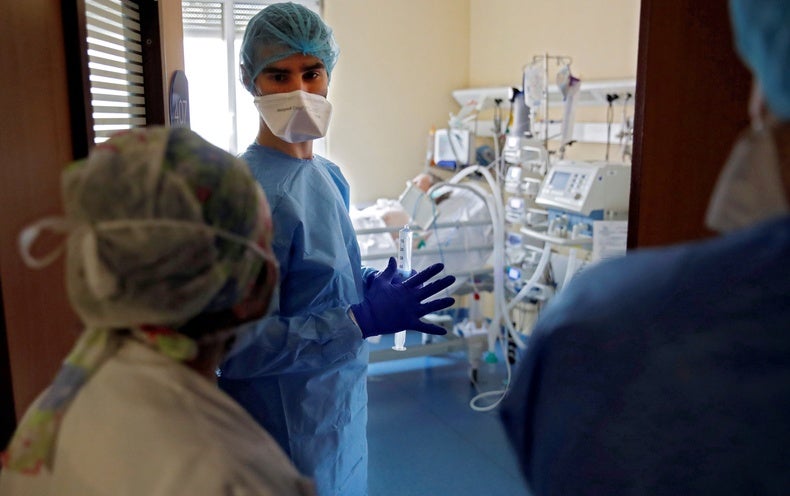
Students studying to become physicians were sent home as the COVID-19 pandemic worsened. Just as many of them were about to begin new medical careers, they found themselves on the sidelines during the most significant health crisis in their lifetime.
That time off has not been passed binge-watching Tiger King, however. Some students have volunteered to staff coronavirus hotlines or to organize food deliveries. And one group of 30 Harvard Medical School students took a different—and extremely ambitious—approach: during the week of March 15, they worked day and night for 72 hours to devise, from scratch, a new university curriculum focused on COVID-19. The team revealed its offering to the world on “Match Day” (March 20)—when soon-to-be graduates typically learn where they will become residents.
“We're thinking, ‘This is what we’re here for,’” says Michael Kochis, an organizer of the curriculum project. “People are scared. People need us to contribute knowledge or to contribute actual clinical care. Even though we're at the cusp of being able to provide those clinical services, we can actually play a role here by sharing knowledge.”
The curriculum, which was vetted by faculty members, provides a physician’s-eye view into the depths of the pandemic. It begins with first principles: the initial module covers virology and immunology. Readers are told that coronaviruses, in general, have the largest genomes of any RNA-based viruses that infect humans. And the curriculum details our prodigious ability to generate respiratory droplets through a sneeze (40,000 droplets) or cough (3,000) or just by talking (about 600 droplets per minute). A unit on epidemiology compares COVID-19 with the previous H1N1 flu pandemics of 1918 and 2009. Another module teaches how to don and doff personal protective equipment, and how to adjust the settings on a mechanical ventilator.
The curriculum also asks readers to put their thoughts to answering the question “How might the initial mild presentation and later severe disease seen in COVID-19 be explained by the immune response to the virus?” And it has them respond to a query about why this time is different:“Brian has just posted on Facebook: ‘Swine flu was a pandemic, but no one called for us to turn our lives upside down. Why are we freaking out about COVID-19?’ What would you write?”
Further, the curriculum contains units on ethics and patient communication—including methods of expressing empathy, giving bad news and bringing about behavioral changes to prevent infection. “It’s not just [about] training doctors to be technicians or scientists but also humans in the fullest sense,” Kochis says.
A guest book on the curriculum’s Web site has been signed by 2,500 visitors. One of them was a medical student from the Philippines whose city was effectively placed under lockdown. That student noted authorities had “encouraged graduating medical students like myself to try to study this as much as we can—because it is likely we will be deployed very soon to the hospitals due to lack of health workforce. Learned a lot from your modules, am very grateful.”
The curriculum—which is being translated, in whole or in part, into 10 other languages—may also help fourth-year students in the U.S. who are graduating early so they can serve as recruits in fighting the new coronavirus. Kochis says he knows of about 10 schools that are incorporating portions of the project into their classwork. “This curriculum is fabulous in so many ways,” says Margaret L. Plews-Ogan, an associate professor of general medicine at the University of Virginia School of Medicine, which is planning to use the new material to build a broader course for its students. She adds that the authors “know that very soon it will be them on the front lines”—and the curriculum can help their peers prepare.
Cammie Lesser and Max Nibert of Harvard teach a monthlong third- and fourth-year class in microbiology and infectious diseases—and they say the students’ new text will help. “We see a great benefit in being able to use their curriculum as a source of background and preparatory readings for our course,” Nibert says.
Wolfram Goessling, a professor of medicine at Harvard who served as a faculty adviser for the effort, says the knowledge gap between teachers and students is minimal for an emerging disease such as COVID-19. This project, he adds, can “serve as a case study for how students can immediately be involved in contributing to a curriculum on emerging and novel topics.”
If you’ve had enough of the cable news bulletins and want to engage in a bit of social distance learning, you can access the Medical Student COVID-19 Curriculum here. The information is being updated every Friday.
Read more about the coronavirus outbreak here.
"how" - Google News
April 09, 2020 at 05:45PM
https://ift.tt/2XhKe94
How to Think about COVID-19 like an M.D. - Scientific American
"how" - Google News
https://ift.tt/2MfXd3I
Bagikan Berita Ini















0 Response to "How to Think about COVID-19 like an M.D. - Scientific American"
Post a Comment